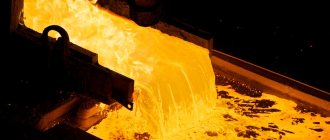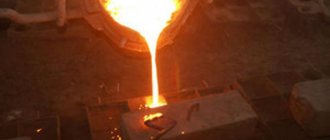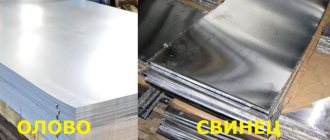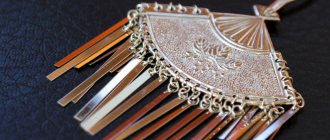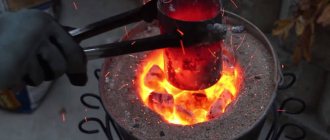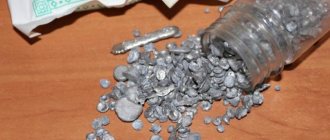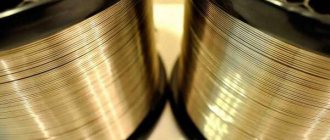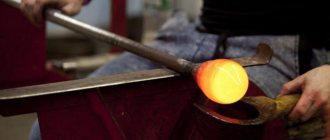Silver – a metal capable of taking on the consistency of a liquid fraction in a molten state. Silver smelting process - a labor-intensive task that requires not only the necessary materials and tools, but also knowledge in this area.
Liquid metal is a very hot material. If handled carelessly, it is easy to get burned. There is also a high risk of fire. Therefore, smelting silver at home should be carried out in a specially designated room or outdoors.
General information
Metal has been known to man since ancient times. Silver scrap was considered a strong and durable device, which ancient people learned to make even before our era. In addition, the material was often found in its native form; there was no need to melt ores to extract pure raw materials. Despite information from history claiming that ancient people did not know how to properly handle metal, today archaeologists find many household items and weapons made before our era.
The cultural traditions of different peoples differed, but many revered precious raw materials as a symbol of the moon. The population of Babylon and Assyria considered it to be a sacred metal. In the middle of the 12th century, most alchemists used the material in their experiments, which was possible due to its unique chemical properties.
Today, raw materials are mined in large quantities in Canada, Sweden, the USA, Russia, Kazakhstan, Norway, the Czech Republic and Slovakia. Many deposits make it possible to sell finished products at an adequate price. There is no shortage of metal today.
Physical properties
Refined metal has many advantages that distinguish it from more expensive materials. However, the main disadvantage is the rapid oxidation of silver and its entry into a chemical reaction with hydrogen sulfide. The substance is found in excess in the air. This is why silver jewelry quickly darkens.
For this reason, some prefer to choose products from other metals. Silver has the following physical properties:
- It has a high density, allowing the material to be used for the production of fine weaving, foil, and wire.
- The reflection coefficient is 95%. The high rate is ensured due to the light shade and shine of well-processed metal.
- High electrical and thermal conductivity allows the use of silver in the manufacture of industrial objects, microcircuits and contacts. The cost of a refined ingot is high, so manufacturers prefer to use a low grade.
- The melting point of silver at home and in production is almost the same if you take bars of the same size and standard.
- The density of silver is 10.5 g per cubic centimeter. The indicator exceeds the density of water by almost 10 times.
- The melting point of technical silver is slightly lower than the figure for a high-quality ingot. This is due to the amount of pure metal in the ingot or piece. A higher percentage increases the score significantly.
It is worth knowing that remelting a 925 sample item will be easier than carrying out the procedure with a 999 sample ingot or jewelry. The latter is used extremely rarely, since jewelry and household items made from such silver are quite soft and do not hold their shape well.
Step-by-step melting of silver at home
To create a cute little thing or an unusual accessory out of silver, you don’t have to turn to specialists. Buy the blank in advance. If not in the store, make the mold yourself, only fireproof and non-flammable materials should be available.
In the absence of technological equipment, a silver ingot is melted using the following devices and materials:
- Metal.
- Metal spoon.
- Asbestos sheet.
- Burner.
- Tweezers and tweezers.
- Borax.
- Mold made of gypsum and quartz sand.
Gloves are put on your hands, and your eyes are protected with special glasses. The mold is created using beeswax, which holds together a mixture of gypsum and quartz sand. The molten material is later poured into the resulting model. But before that it still needs to be warmed up. If work is carried out in a room, open a window. Then the unpleasant air will disappear faster. The readiness of the mold is determined by the absence of the characteristic odor of the material.
Application area
Affordable cost, ductility and ease of processing allow the metal to be used in industry and everyday life. The most common applications are as follows:
- production of jewelry, various decorations in combination with other metals, precious and semi-precious stones;
- production of original tableware;
- multilayer ceramic capacitors, relay contacts;
- as part of the cathodes of galvanic cells;
- minting of coins, special awards, orders;
- application in climate control in an alloy with silver iodide;
- as a coating for original handmade mirrors;
- as a catalyst in oxidation reactions.
In addition, humanity discovered the disinfecting properties of metal several centuries ago. In Ancient Rome and Persia, water was stored in silver vessels for important gentlemen, military men, and soldiers.
It is worth noting that in jewelry they often used not pure material, but its alloy with copper or other types of raw materials. It was then that the craftsmen began to be interested in the topic of melting silver at home, because most of them worked at home.
Technical and jewelry silver
For technical purposes, the most important are the maximum indicators of reflectivity, electrical and thermal conductivity. The melting point of real silver is also of greatest importance. Therefore, it must be at least 999th standard. But for jewelry, strength, hardness, wear resistance, and good casting properties are more important. The most common jewelry alloys:
- 960 sterling silver contains 96% of this material, is very soft and ductile, and is used in highly artistic elements of exquisite jewelry that are not subject to mechanical stress. Melts at 900−940°C.
- The 925 alloy is called sterling silver, or standard silver; it has a dazzling white color, excellent wear resistance and strength; coins were previously minted from it. Now this jewelry alloy has become most widespread in the production of various jewelry (chains, bracelets, rings and earrings), fine cutlery and dishes. The melting point of 925 silver is 810−940°C.
- The 875th sample of lunar metal is used in the manufacture of cutlery, spoons, forks, and jugs. For jewelry, this silver is considered to be of insufficient quality, since a significant copper content worsens the appearance of the jewelry.
- The 800-karat alloy is mainly used in writing and cutlery, it is highly wear-resistant and has a yellowish tint. In Russia, this indicator for silver is considered minimal. Melting of lunar metal of 800 standard occurs at 779−820°C.
According to the data in the table, you can find out at what temperature silver of different samples melts.
| Try | Density, g/cm3 | Melting area, ºС | Tensile strength, kgf/mm2 | Relative extension, % |
| 999 | 10,39 | 960 | 18 | 49 |
| 960 | 10,35 | 900 — 940 | 22 | 35 |
| 925 | 10,29 | 810 — 910 | 30 | 29 |
| 900 | 10,30 | 779 — 890 | 30 | 26 |
| 875 | 10,16 | 779 — 870 | 30 | 33 |
| 800 | 10,13 | 779 — 820 | 31 | 30 |
Preparation for the procedure
In production conditions, it is not difficult to ensure a suitable melting temperature for silver. The workshop is usually equipped with special stoves, gas, casting molds, tools, and fireproof stands. Personnel are provided with clothing made from materials that are not subject to fire.
The process has a high fire hazard, so if you try to melt any product at home, it is recommended to carefully prepare. It is extremely rare for an amateur to perform a procedure with a large amount of silver. Typically, antique jewelry or parts thereof, massive, torn chains, large pendants or earrings that do not have a pair are used.
You can melt such material at home with proper preparation of the room. It is important to ensure good ventilation, preferably forced ventilation. This will allow the vapors to quickly evaporate, and the person will not inhale harmful substances. It is necessary to prepare the following items:
- steel container in which the products will be located;
- a special form into which the material will be poured after melting;
- protective clothing, face mask, goggles, fire-resistant gloves;
- gas or gasoline burner;
- asbestos sheet;
- professional tongs.
To work with hot metal, special suits are usually worn. It is recommended to protect your eyes with glasses that fit tightly to the skin; it is better to additionally protect your face with a mask. During melting, contact with a hot spark on the skin or cornea will certainly lead to a severe burn.
Tongs allow you to eliminate direct contact of human hands with the molds and container where the material will melt. Some carry out the procedure in the kitchen.
It is recommended to remove all flammable items. Experts advise setting aside a separate room for such manipulations, for example, a garage or workshop.
Step-by-step instruction
The melting point of 925 silver is +960−970 degrees, depending on the thickness of the product. Items with a lower standard or alloys with silver can melt already at +710 degrees. Experts say that the percentage of pure metal affects melting.
At a temperature of +2210 degrees, silver boils, so creating such conditions yourself is not recommended. Some people use a gas stove to manipulate silver. It is recommended to take into account that it is necessary to choose dishes that can withstand temperatures of at least +1000 degrees.
In specialized stores you can purchase special dishes designed for melting. All materials must be prepared in advance and placed in an accessible place. To prevent spontaneous combustion of furniture, an asbestos sheet is used, located on a table or other surface. Even if a spark or a drop of material enters, the risk of fire is minimized.
Alloy purification
If the manipulation will be carried out not with pure material, but with an alloy, it must first be cleaned of impurities. This is a separate procedure that is strictly prohibited to be performed independently, indoors. During cleaning, metals release toxins that are dangerous to the human body; if inhaled, poisoning develops quickly.
Cleaning occurs in several stages. The first is to place the silver, divided into several pieces, into a jar of nitric acid. The time it takes to free the metal from impurities varies. You should focus on the color of the acid. If it turns reddish, the cleaning was successful.
After this, a sodium chloride solution is added to the jar. Good silver will sink to the bottom. Next, clean water is added to the jar and drained after a few minutes. It is necessary to repeat the manipulations until the water becomes clear after topping up and light powder or granules settle to the bottom. They can be melted.
Melting technology
At home, melting silver is usually carried out in order to obtain some kind of jewelry, so it is necessary to prepare the mold in advance. If you choose the right one, after injecting the material, no additional actions will be needed. Sometimes the alloy should be rolled out to get smooth lines without sharp transitions.
The first step is to place a heatproof pan on the burner. Only after heating it is necessary to add purified powder or small pieces of silver if it does not need preliminary cleaning. When observing the heating, a person will notice how the crystals or pieces change shape and shade. The speed of the process depends on the size of the placed material.
Molten metal resembles a puddle of gasoline or mercury. The presence of a cloudy film on it indicates that the process is not over.
After the cloudy film disappears, you must quickly grab the container with tongs and carefully pour it into the prepared form. All movements must be clear, confident, fast, but very careful. Any jerk or delay will prevent you from realizing your plans.
If the prepared mold has a lid, place a piece of cotton wool of suitable size under it before closing it. During combustion, the material creates a certain pressure necessary for uniform distribution of the metal throughout the shape. In this case, you do not have to additionally roll out the mass.
Final stage
After crystallization of the material, it is necessary to separate it from the mold and place it in cold water. If all steps are performed correctly, the process is not difficult; the piece of silver separates on its own. If this does not happen, you should extract the silver yourself using tools.
Usually, the manipulations do not end at this stage, since it is necessary to make fastenings or other holes in the case when casting was carried out for the purpose of making jewelry. It is almost impossible to perform the procedure at home, especially in the absence of certain skills. To do this you will need tools and knowledge of jewelry making. Beginners stop there and give the master the opportunity to finish the job.
Melting silver at home is a complex, labor-intensive and often dangerous process that requires extreme concentration, composure, certain skills and suitable tools. Despite the apparent simplicity of implementation, it is strongly not recommended to do this in the absence of basic knowledge. Experts are also categorically against carrying out manipulations in a private house or apartment.
Silver smelting process
You need to prepare the form in advance. Quartz sand and gypsum are mixed in a ratio of 7:1. The finished mixture is diluted with water to the consistency of sour cream. Next, you should choose a box for the form. Its dimensions should not be very large, but sufficient to freely place the product. The box must have a voluminous lid into which the product can also fit. You can take 2 identical boxes. The prepared mixture is poured into one box. Carnations are installed in its corners. The pre-selected model of the product must be covered with soapy water and dried.
After this, the model is carefully immersed in the mixture to the middle of its height. You need to make sure that the nails remain pointing straight up. The hardened mixture must be coated with oil. The lid of the box is filled in the same way. Then the box with the layout must be connected to the lid, immersing the free part of the layout in the fresh mixture. When everything is thoroughly dry, the finished forms can be removed from the boxes. A small hole (up to 5 mm in diameter) is made in one of the molds for pouring metal. After this, the forms are carefully connected and secured in this position with a rope or elastic band.
After preparing the mold, the silver smelting process begins. Silver items are placed in a crucible. It is better to first break them into equal pieces. This way the metal will heat up evenly and the process will speed up a little. The crucible is heated on a gasoline or gas burner. Metal ready for casting looks like a drop of mercury. If this state is achieved, you can pour silver into the mold. To fill, you need to use a special funnel. After the molten metal is completely poured, the hole must be very quickly closed with a lid. On the inside of the lid you need to place a small piece of cotton wool in advance. Instantly burning from the high temperature, the cotton wool will create pressure in the closed container. Thanks to this pressure, the metal will evenly fill all the corners and bends of the form.
